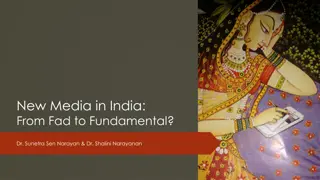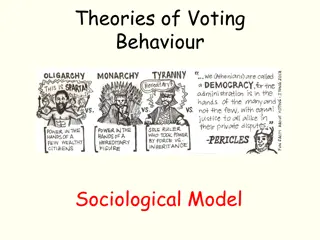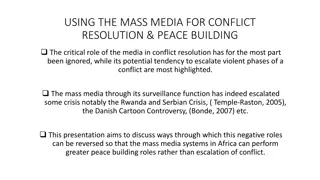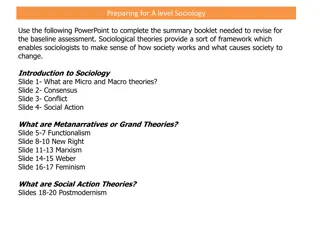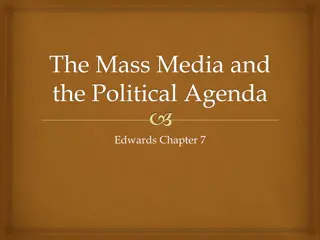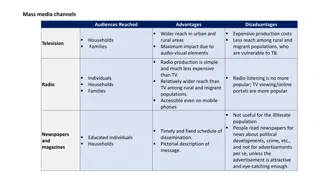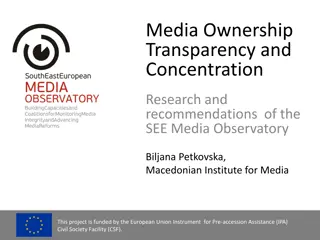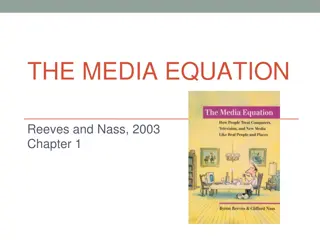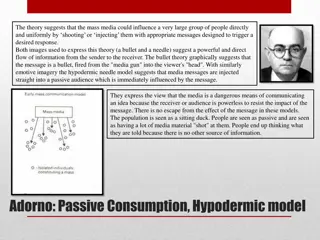Sociological Perspectives on Mass Media
Sociological perspectives on the mass media explore its role as an agent of socialization, enforcer of social norms, and conferrer of status. These perspectives also examine functions such as surveillance of the social environment, gatekeeping, dominant ideology, and feminist views on gender representation.
Download Presentation

Please find below an Image/Link to download the presentation.
The content on the website is provided AS IS for your information and personal use only. It may not be sold, licensed, or shared on other websites without obtaining consent from the author.If you encounter any issues during the download, it is possible that the publisher has removed the file from their server.
You are allowed to download the files provided on this website for personal or commercial use, subject to the condition that they are used lawfully. All files are the property of their respective owners.
The content on the website is provided AS IS for your information and personal use only. It may not be sold, licensed, or shared on other websites without obtaining consent from the author.
E N D
Presentation Transcript
Chapter 7 The Mass Media
Sociological Perspectives of the Media Functionalist View Agent of Socialization Increase social cohesion by presenting a more or less standardized, common view of culture through mass communication; provide a collective experience for members of a society. Enforcer of Social Norms reaffirm proper behavior by showing what happens to people who act in a way that violates societal expectations; shape perceptions about the risks of substance use, although not necessarily in a positive fashion. Conferral of Status confer status on people, organizations, and public issues; People magazine. 2
Surveillance of the Social Environment the collection and distribution of information concerning events in the social environment; stock market quotations, weather forecast, election campaigns, sport events, etc. Dysfunctional Media: the Narcotizing Effect refer to the phenomenon whereby the media provide such massive amounts of information that the audience becomes numb and generally fails to act on the information, regardless of how compelling the issue. 3
Conflict View Gatekeeping A relatively small number of people control what eventually reaches the audience; in many countries, the government plays a gatekeeping role; 60% of the top five TV stations and 72% of the largest radio stations are government-owned (World Bank, 2001). Gatekeeping is not as dominant in the Internet. Dominant Ideology: Constructing Reality Powerful groups may limit the representation of others in the media; the set of cultural beliefs and practices that help to maintain powerful social, economic, and political interests. 4
Dominant Ideology: Whose Culture? Movies produced in the U.S. account for 65% US risk being ethnocentric if they overstress US dominance and assume other nations do not play a role [e.g., Survivor (Sweden), Who Wants to Be a Millionaire (Britain), Iron Chef (Japan)] Cultural domination goes beyond films, books, magazines, and TV programs. It also applies to what ideas and facts get transmitted. 5
Feminist View Women are underrepresented Men and women are portrayed in ways that reflect and perpetuate stereotypical views of gender. Depictions of male-female relationships emphasize traditional sex roles and normalize violence against women. 6
Interactionist View Especially interested in shared understandings of everyday behavior. Friendship networks can emerge from shared viewing habits or from recollection of a cherished television series from the past. Family members and friends often gather for parties centered on the broadcasting of popular events such as the Super Bowl or the Academy Awards. 7
The Audience Who is in the audience? Audience is somewhat distinctive in terms of age, gender, income, political party, formal schooling, race, and ethnicity. The segmented audience Advertising media specialists have sharpened their ability through survey research to identify particular target audiences. Audience behavior Despite the role of opinion leaders. Members of an audience do not all interpret media in the same way. Often their response is influenced by social characteristics such as occupation, race, education and income. 8
The Media Industry Media concentration Ownership is getting more and more centralized; a prime example was the merger in 2001 of AOL and Time Warner. Similar concerns are raised about the situation in such countries as China, Cuba, North Korea, where the ruling party owns and controls the media. The media s global reach Physical distance is no longer a barrier, and instant messaging is possible across the world. The media are not only broad in reach but they permeate all aspects of everyday life. The internet has facilitated other forms of communication. Reference materials and data banks can be made accessible across national boundaries. 9



